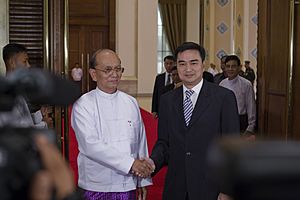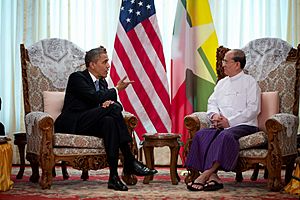Thein Sein facts for kids
Quick facts for kids
Thein Sein
|
|
|---|---|
|
သိန်းစိန်
|
|

Thein Sein in 2013
|
|
| 8th President of Myanmar | |
| In office 30 March 2011 – 30 March 2016 |
|
| Vice President | Tin Aung Myint Oo Sai Mauk Kham Nyan Tun |
| Preceded by | Than Shwe (Chairman of the State Peace and Development Council) |
| Succeeded by | Htin Kyaw |
| Prime Minister of Myanmar | |
| In office 12 October 2007 – 7 November 2010 Acting: April 2007 – 12 October 2007 |
|
| Leader | Than Shwe |
| Preceded by | Soe Win |
| Succeeded by | Min Aung Hlaing (2021) |
| Secretary 1 of the State Peace and Development Council | |
| In office 19 October 2004 – 12 October 2007 |
|
| Preceded by | Soe Win |
| Succeeded by | Tin Aung Myint Oo |
| Secretary 2 of the State Peace and Development Council | |
| In office 25 August 2003 – 19 October 2004 |
|
| Preceded by | Soe Win |
| Succeeded by | Tin Aung Myint Oo |
| Member of Parliament for Zabuthiri |
|
| In office 31 January 2011 – 30 March 2011 |
|
| Preceded by | Constituency established |
| Succeeded by | Sanda Min |
| Majority | 65,620 (91.2%) |
| Personal details | |
| Born | 20 April 1944 Kyounku, Burma (now Myanmar) |
| Political party | Union Solidarity and Development Party (2010–2016) |
| Spouse | Khin Khin Win |
| Children | 3 |
| Alma mater | Defence Services Academy |
| Military service | |
| Allegiance | |
| Branch/service | |
| Years of service | 1968–2010 |
| Rank | |
Thein Sein (Burmese: သိန်းစိန်; born on April 20, 1944) is a politician from Myanmar. He was also a military general before he retired. He served as the 9th President of Myanmar from 2011 to 2016. Before that, he was the Prime Minister of Myanmar from 2007 to 2010. Many people in Myanmar and around the world saw him as a leader who brought important changes to the country after a long period of military rule.
During his time as president, his government made several big changes. They made the country's media less controlled and let many political prisoners go free. They also stopped a large dam project that was causing controversy. Because of these changes, Myanmar was chosen to lead the ASEAN group in 2014. Relations with the United States also got better. A famous opposition leader, Aung San Suu Kyi, was released from house arrest. Her political party, the National League for Democracy (NLD), was also allowed to take part in elections again in 2012.
Contents
Early Life and Family
Thein Sein was born in 1944 in a small village called Kyonku. This village is located in the Irrawaddy Delta region of Myanmar. He was the youngest of three children. His parents were farmers who did not own land. His father worked by carrying goods at the river and making bamboo mats. Later in life, after Thein Sein's mother passed away, his father became a Buddhist monk.
Military Career
Thein Sein joined the military and graduated from the Defence Services Academy in 1968. He earned a degree in arts and became a second lieutenant. Throughout his 40 years in the military, he was known more as someone who managed things behind a desk rather than a soldier who fought in battles.
He held various important positions. In 1988, he was a major in the 55th Light Infantry Division. He later commanded an infantry battalion. He continued to rise through the ranks. By 1991, he was a colonel in the War Office in Yangon. He was then promoted to brigadier general. In 1993, he became a commander in the Yangon Division. Three years later, he led the Triangle Regional Military Command in Shan State.
In 1998, Thein Sein became a member of the State Peace and Development Council, which was the ruling military government. He was appointed as Secretary-2 in 2001 and became a lieutenant general. In 2004, he was promoted to Secretary-1 and then to the rank of general.
Becoming Prime Minister

In April 2007, the military government chose Thein Sein to be the temporary prime minister. He took over from General Soe Win, who was sick. After General Soe Win passed away in October 2007, Thein Sein officially became the permanent prime minister.
He was also the first secretary of the ruling military council. He was the fourth-highest ranking general in the country. He also led a government committee that organized a national meeting. As prime minister, Thein Sein held important discussions with leaders from countries like Bangladesh and Cambodia.
In 2007, he was promoted to the rank of general. He made his first official visit outside Myanmar as prime minister, meeting with leaders in Laos, Vietnam, and Cambodia. In 2008, after a very strong storm called Cyclone Nargis hit Myanmar, he led the committee for disaster preparedness. However, his government faced criticism for making it difficult for aid to reach people who needed it.
Presidency
Election and Taking Office
In April 2010, Thein Sein retired from the military. He then became a civilian leader of the Union Solidarity and Development Party (USDP). In the 2010 general election, his party won most of the seats in the parliament. Thein Sein himself won a seat representing Zabuthiri Township.
On February 4, 2011, the parliament elected him as the next President of Myanmar. He became the first civilian president in Myanmar in 49 years. He took his oath of office on March 30, 2011, along with two vice-presidents and the new parliament members.
Working with Other Countries
Early in his presidency, Thein Sein asked for support from the head of ASEAN for Myanmar to lead the ASEAN Summit in 2014. His request was successful, and Myanmar hosted the ASEAN summit in Naypyidaw that year.
Changes at Home
Thein Sein was seen as a moderate leader because he was willing to talk with Aung San Suu Kyi, a key opposition figure. They had an important meeting in August 2011. He also suggested that Burmese citizens living abroad could return home if they had not committed any crimes. This was seen as an invitation for them to help rebuild Myanmar's economy.

In 2012, Thein Sein suggested that the Rohingya people, a minority group who had lived in Myanmar for hundreds of years, should be moved to other countries. The United Nations quickly disagreed with this idea. Thein Sein also supported policies that did not recognize Rohingya as citizens. He stated that the 2012 violence in Rakhine State was not about race or religion.

Cabinet Changes
In August 2012, Thein Sein made big changes to his cabinet, which is the group of ministers who help run the government. He changed 9 ministers and 15 deputy ministers. This helped him strengthen his power by replacing ministers who were more traditional with those who supported his ideas.
Role in His Political Party
In October 2012, Thein Sein was re-elected as the chairman of the Union Solidarity and Development Party (USDP). However, Myanmar's constitution says that the president should not take part in party activities while in office. Because of this, Thein Sein handed over the chairman position to Shwe Mann in May 2013. Even so, he continued to be an important leader within the party.
After Being President
After Thein Sein left office on March 30, 2016, he became a Buddhist monk for a few days. This is a common tradition for Burmese Buddhist men. He was temporarily ordained in a monastery in Pyin Oo Lwin and was known by the monastic name U Santidhamma.
Since then, Thein Sein has lived a quiet life in retirement. He did not speak publicly about the military takeover in Myanmar in 2021. However, in April 2023, he gave an interview. He said that the previous military government had kept the country isolated for 20 years. He also mentioned that he personally worked to end international restrictions on Myanmar during his presidency.
Personal Life
Thein Sein is married to Khin Khin Win. They have three daughters. One of his daughters is married to a military captain. Thein Sein has a heart condition and uses a pacemaker.
Images for kids
See also
 In Spanish: Thein Sein para niños
In Spanish: Thein Sein para niños





